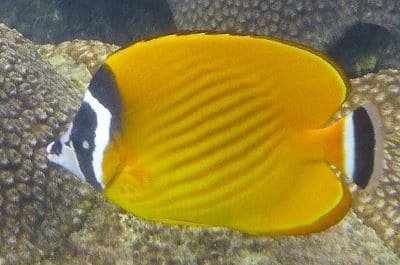Home › Global Destinations › Asia › Thailand › Koh Tao › Shark Island
Scuba Diving at Shark Island Koh Tao
Koh Tao shark island gets its name from large granite rocks, rising several metres above sea level, that bear some resemblance to a shark's dorsal fin.
This guide contains information about Shark Island dive site, including maximum depth levels, recommended diver training, and the marine biodiversity living around the reefs.
What Months are Best for Diving in Koh Tao
In fact, the Chumphon Archipelago contains dozens of sun-kissed bays on the islands. But, the premier spots for divers and snorkelers are:
- Koh Phangan
- Koh Samui
- Mu Ko Chumphon National Park
- Turtle Island (Koh Tao)
Koh Tao is a compact kidney-shaped island that has about twenty one (21) square kilometres of total land mass.
Nevertheless, the pristine white sand beaches and azure blue water have transformed Koh Tao Island into one of the top places for scuba diving holidays in southern Thailand.
Here's the thing:
Most scuba divers want to explore destinations that are sunny and have calm conditions underwater. Well, Koh Tao has over three hundred days of year-round sunshine and the temperature of the water is a constant 29° Celsius (84° Fahrenheit).
As a consequence of that, it's fair to say diving in Koh Tao is an annual activity. But, divers need to be mindful that the southwest monsoons usually arrive towards the end of October and may continue until the end of January.
At certain times of the year, the south western gulf can have thirty (30) metres of underwater visibility. Hence, the best months for divers to enjoy clear water dives are July, August, and September.
Pro Tip: In general, the sharks in Koh Tao are not aggressive to humans. Our sea life section has interesting facts about whale sharks that often make an appearance around the outer islands during the months of April, May, and June.
Tips for Diving at Shark Island Thailand
Take a fifteen minute boat journey south of Laem Kong Sai Daeng in Koh Tao and the pinnacles of Shark Island will appear as they protrude above the water.
Divers who make the trip will find fringing coral reef systems that attract a motley crew of marine mollusks, moray eels, and ray fishes into the crevices in search of food.
The water around this "geological shark fin" is not deep, around 4 metres in places, so it offers some opportunities for snorkeling activities as well. But, scuba divers can descend all the way down to the sea bed around fifteen (15) metres below.
You'll find the fish life more prevalent on the eastern side of the rocks. This is where you should see a sloping reef garden adorned with brain corals and giant barrel sponges.
Pro Tip: Shark Island diving spot is deep and less protected from strong currents. Thus, the recommended scuba training for this location includes PADI Advanced Open Water Diver, PADI Deep Diver, and PADI Fish Identification.
Marine Life at Shark Island Dive Site
Koh Tao dive sites are good places to see big fishes (e.g. pelagics). Plus, divers should expect to catch sightings of common marine life native to the lower Gulf of Thailand, especially during the plankton blooms in March and April, such as:
- Banded Coral Shrimp (Stenopus hispidus)
 Batfish (Platax teira)
Batfish (Platax teira)- Blackcap butterflyfish (Chaetodon wiebeli)
- Bearded scorpionfish (Scorpaenopsis barbata)
- Bluespotted Ribbontail Ray
- Bigeye Trevally (Caranx sexfasciatus)
- Christmas tree worm (Spirobranchus giganteus)
- False moorish idol (schooling bannerfish)
- Juvenile harlequin sweetlips (Plectorhinchus chaetodonoides)
- Pink Skunk Clownfish (Amphiprion perideraion)
- Malabar grouper (Epinephelus malabaricus)
- Scrawled filefish (Aluterus scriptus)
- Sea Anemones (phylum Cnidaria)
- Sea Sponges (phylum Porifera)
- Spanish Mackerels (Scomberomorini)
- Talang Queenfish (Scomberoides commersonnianus)
- Yellowtail Barracuda (Sphyraena flavicauda)
- Yellowtail Fusilier (Caesio cuning)
Pro Tip: The sites offer good opportunities to explore sea life that lives around hard and soft corals. For example, hard varieties include brain, table, staghorn corals, and lobe coral (Porites lobata). The soft coral species at Shark Island include mushroom coral, toadstool leather corals (Genus Sarcophyton), and various types of whip corals.
Related Information and Help Guides
- Aow Leuk Dive Site Koh Tao for Diving and Snorkeling
- Hin Wong Bay Dive Site Koh Tao East Coast in Thailand
- Information about Shark Point Dive Site in Phuket
- Is Chumphon Pinnacle the Best Place to Dive in Koh Tao?
- Laem Thian Dive Sites in Koh Tao for Beginners
- HTMS Sattakut Wreck Dive Site Koh Tao Thailand
- Sail Rock Dive Site in the Lower Gulf of Thailand
- The Best Scuba Diving and Snorkeling Sites in Koh Samui
Pro Tip: This short clip [3:19 seconds] presented by "Fat Fish Movies" contains footage of sea creatures in their natural habitat at Shark Island dive site in Koh Tao, Thailand.